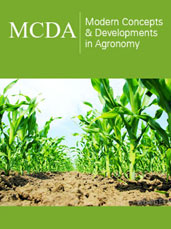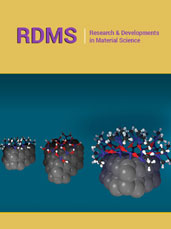- Submissions

Full Text
Modern Concepts & Developments in Agronomy
Applications and Challenges of Nanozymes in Agriculture
Yifan Lei and Chen Li*
School of Life Science, Shanxi University, China
*Corresponding author:Chen Li, School of Life Science, Shanxi University, Taiyuan, 030006, China
Submission: January 29, 2025;Published: February 07, 2025

ISSN 2637-7659Volume15 Issue 1
Abstract
Nanozymes, as a novel type of catalyst, have shown broad application potential in the agriculture field in recent years, especially in promoting plant growth, enhancing stress resistance, and detecting pesticide residues. Research indicates that nanozymes can effectively improve the physiological characteristics and environmental adaptability of plants, while also providing rapid and sensitive detection methods for pesticide monitoring. However, the application of nanozymes faces challenges such as safety, stability and selectivity. This article focuses on the current status of nanozyme application in agriculture and the challenges they encounter, aiming to reveal the significance of nanozymes for sustainable development of agriculture.
Keywords:Nanozymes; Agriculture; Applications; Challenges
Abbreviations:ET/JA: Ethylene/Jasmonic Acid; CDs: Carbon Dots; OPs: Organophosphorus Pesticides
Introduction
Nanozymes are nanomaterials that possess enzymatic catalytic activity. Compared to natural enzymes, nanozymes exhibit notable advantages in several aspects, such as enhanced stability, environmental adaptability, and lower production costs [1]. The catalytic mechanism of nanozymes primarily relies on their unique surface properties and structural features, making them highly promising for applications in areas like biocatalysis and environmental monitoring. Characterized by their intrinsic enzyme-like activity, nanozymes include various types, such as metal-based, metal oxide-based, and carbon-based nanozymes [2].
In the field of agriculture, research on the applications of nanozymes mainly focuses on promoting plant growth, enhancing plant stress resistance, and detecting pesticide residues. These efforts aim to provide new approaches for improving agricultural production efficiency and ensuring food safety.
Applications of Nanozymes in Agriculture
Infections by various plant pathogens are very common during plant growth. The use of pesticides often leads to environmental pollution. However, the emergence of nanozymes offers new possibilities for the green management of plant diseases. Recent studies have indicated that vanadium carbide MXene nanosheets (V2C-NSs) may induce plant resistance to bacterial wilt Ralstonia solanacearum via the ET/JA (ethylene/jasmonic acid) pathway [3]. Conducted through indoor experiments and bioassays, this study found that V2C-NSs can effectively delay the onset of disease, activate plant defense enzymes, and up-regulate the expression of genes involved in plant hormone synthesis. These findings provide new insights into the green control of tobacco bacterial wilt disease. With the intensification of global climate change, plants are facing increasing environmental stress, particularly due to factors such as drought, salinity, and chemical pollution, all of which significantly impact plant growth. Carbon dots (CDs) have been shown to promote plant growth, with numerous studies indicating that CDs can enhance plant resistance to abiotic stresses, thereby increasing crop yields [4]. Synthesized carbon dots possess superoxide dismutase-like and peroxidase-like activities, effectively mitigating the toxic effects of fipronil stress on plants. By reducing the accumulation of superoxide anions and hydrogen peroxide, carbon dots enhance plant defense mechanisms and up-regulate the expression of related detoxification genes, significantly lowering pesticide residues in plants [5].
Nanozymes have shown promising applications in the detection of pesticide residues. For instance, a portable device has been developed based on ultra-small CuOx/GDYO nanozymes capable of effectively detecting organophosphorus pesticides (OPs). This nanozyme can modulate the competitive redox reaction when reacting with pesticide residues, initiating a colorimetric reaction that allows for the detection of OPs at a limit as low as 0.57nM [6]. This facilitates the direct monitoring of pesticide residues in agricultural production. A photoelectrochemical sensor made with Fe/ZnO nanozymes has been used to detect glyphosate [7]. Glyphosate can inhibit the activity of Fe/ZnO nanozymes via electrostatic interactions, enabling selective detection and successful application in real sample analysis. Therefore, copper- and iron-based nanozymes perform well in the detection of pesticide residues, particularly in the detection of organophosphorus pesticides. Additionally, a dual-mode biosensor has been constructed for the photoelectrochemical and colorimetric detection of organophosphorus pesticides [8]. This sensor utilizes an ultra-thin FeOOH-coated MnO2 (MO@FHO) nanozyme, which exhibits excellent performance in complex biological matrices. It enables rapid, sensitive pesticide monitoring via a smartphone platform. These studies demonstrate that nanozymes, by mimicking the activity of natural enzymes, can effectively detect pesticide residues, thereby enhancing food safety.
Challenges of Nanozymes in Agriculture Applications
Although the growing advantages of nanozymes, their application in agriculture still faces challenges. The catalytic activity and stability of nanozymes are influenced by their synthesis methods, environmental conditions (such as pH and temperature), and the materials used. For example, ultra-small CuOx/GDYO nanozymes, synthesized using an electrochemical method, exhibited excellent catalytic activity and stability. However, minor variations in the synthesis process may significantly affect their performance, limiting their feasibility for practical agricultural applications [6]. Nanozymes also face selectivity and specificity issues in the detection of pesticide residues. Relevant literature has highlighted that, although nanozyme-based sensors can rapidly detect pesticide residues, non-specific inhibition remains a challenge for sensor performance. This issue needs to be addressed in the design of specialized sensor [1]. Given the varying chemical properties of different pesticides or contaminants, developing nanozyme sensors that maintain consistent sensitivity under diverse environmental conditions remains a challenge. The safety and biocompatibility of nanozymes are also critical concerns. The accumulation of some nanozymes in plants may pose potential risks to the ecosystem, especially when used at high concentrations, which could disrupt the food chain [8]. Therefore, when promoting the agricultural application of nanozymes, it is essential to comprehensively consider their environmental impact and safety.
Conclusion
In the agricultural sector, nanozymes not only provide new solutions for crop growth and protection but also offer practical methods for food safety monitoring. Future research should focus on enhancing the performance of nanozymes under diverse environmental conditions to ensure their safety and effectiveness in practical applications. Continuous optimization of the synthesis and functional design of nanozymes will further advance their agricultural applications and contribute to sustainable agricultural development.
References
- Xu X, Sun T, Zhou X, Liu Z, Zhang L (2025) Specific and enzyme-free monitoring of propiconazole pesticide residues in vegetables with a portable nanozyme-based paper sensor. Food Chem 464(Pt 2):141686.
- Ren Y, Bi X, He Y, Zhang L, Luo L, et al. (2025) Research progress and applications of iron-based nanozymes in colorimetric sensing of agricultural pollutants. Biosens Bioelectron 271:116999.
- Wang Y, Liang Y, Ma X, Dong Y, Klakong M, et al. (2024) An environmental-friendly resistance inducer in crop protection: V2C MXene nanosheets induce plant resistance to Ralstonia solanacearum via the ET/JA signaling pathway. Ind. Crops Prod 220:119269.
- Chen F, Shen Z, Shi R, Zhang X, Zhang H, et al. (2024) Carbon dots-mediated plant adaptive responses to abiotic stress. MRS Bulletin 182: 113137.
- Chen F, Zhou Z, Yang N, Jiang Q, Zhang X, et al. (2025) Carbon dots based cascading nanozymes mitigate phytotoxicity in lettuces under imidacloprid stress. Food Chem 464(Pt 3):141926.
- Zhang X, Xue C, Cao H, Wu Y, Yang B, et al. (2024) Ultra-small CuOx/GDYO nanozyme with boosting peroxidase-like activity via electrochemical strategy: Toward applicable colorimetric detection of organophosphate pesticides. Talanta 279: 126639.
- Zou X, Chen Q, Liu Q, Huang X, Tong Y, et al. (2025) Triethylamine regulated MOFs-derived peroxidase-like nanozymes for colorimetric analysis of glyphosate with boosted catalytic activity. Microchemical Journal 208: 112314.
- Zuo M, Yang Y, Jiang S, Zhu C, Han Y, et al. (2024) Ultrathin-FeOOH-coated MnO2 nanozyme with enhanced catalase-like and oxidase-like activities for photoelectrochemical and colorimetric detection of organophosphorus pesticides. Food Chem 445: 138716.
© 2025 Chen Li*. This is an open access article distributed under the terms of the Creative Commons Attribution License , which permits unrestricted use, distribution, and build upon your work non-commercially.
 a Creative Commons Attribution 4.0 International License. Based on a work at www.crimsonpublishers.com.
Best viewed in
a Creative Commons Attribution 4.0 International License. Based on a work at www.crimsonpublishers.com.
Best viewed in 







.jpg)






























 Editorial Board Registrations
Editorial Board Registrations Submit your Article
Submit your Article Refer a Friend
Refer a Friend Advertise With Us
Advertise With Us
.jpg)






.jpg)














.bmp)
.jpg)
.png)
.jpg)










.jpg)






.png)

.png)



.png)






